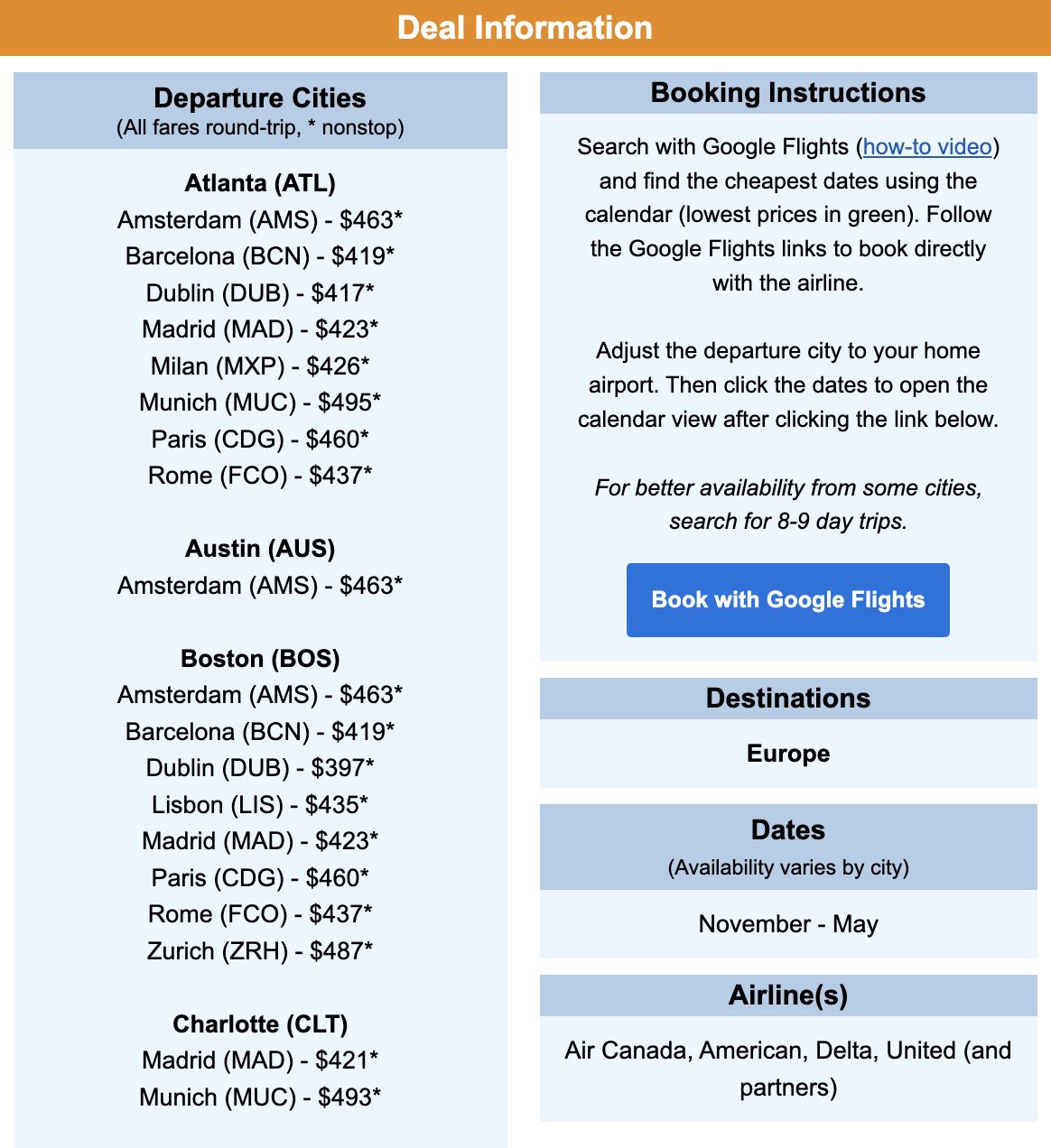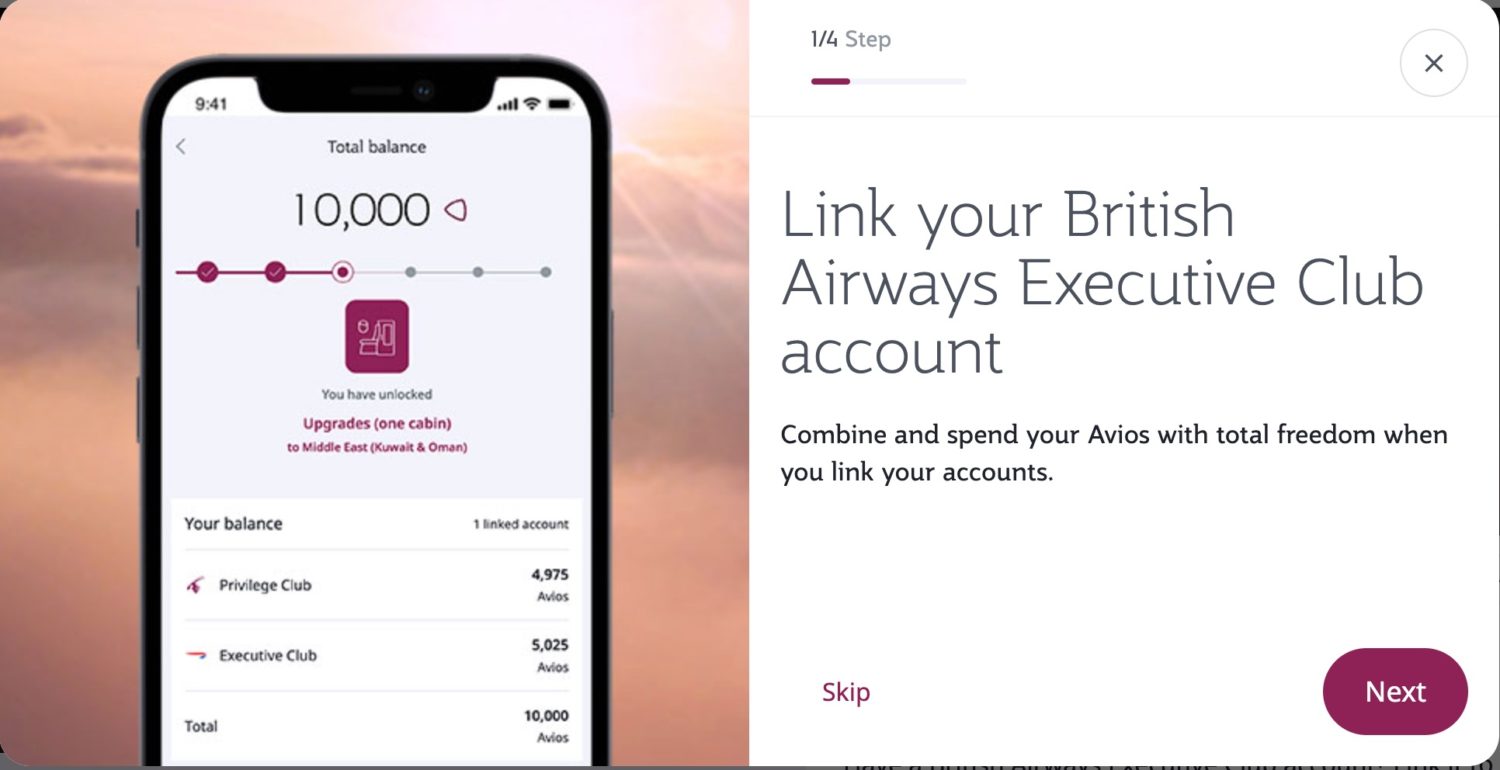Basic economy has spread like wildfire across the globe among the major U.S. airlines and even international carriers, luring in consumers with the cheapest price … in exchange for a […]
Basic economy has spread like wildfire across the globe among the major U.S. airlines and even international carriers, luring in consumers with the cheapest price … in exchange for a bunch of restrictions. But even travelers who swear they'll never book one of these cheap, stingy fares would be wise to learn how they really work.
You get the same economy seat and service like every other passenger, but picking a seat will cost you extra, you'll board the plane last, and canceling for an airline credit typically isn't an option. On some airlines, you can't even bring a carry-on bag onboard. The result? Fares that look like this.
We search for flight deals each and every day for our Thrifty Traveler Premium members, and the cheapest fares – like sub-$100 domestic flights or Europe and back for under $300 – are often in basic economy. But there's good news even for basic economy haters, because…
When prices fall on basic economy tickets, it brings down the price of a main cabin economy ticket, too While practically all airlines sell basic economy nowadays, you still won't see it on some routes Using those airline miles you've saved up is a great way to bypass basic economy altogetherKeep reading for a full breakdown of how basic and main cabin fares differ – and how to get what you need from the airlines.
Basic Economy is Better (& Worse) on Some Airlines
Basic economy might seem cheaper on paper, and it is: It'll save you some money. But you'll pay for it in what you don't get.
When it comes to the differences between basic economy and main cabin, Google Flights lays out the major distinctions neatly when you're searching for tickets on the major U.S. airlines like American, Delta, or United as well as some major international airlines.
Fly with me to Cancún (CUN) for an example.
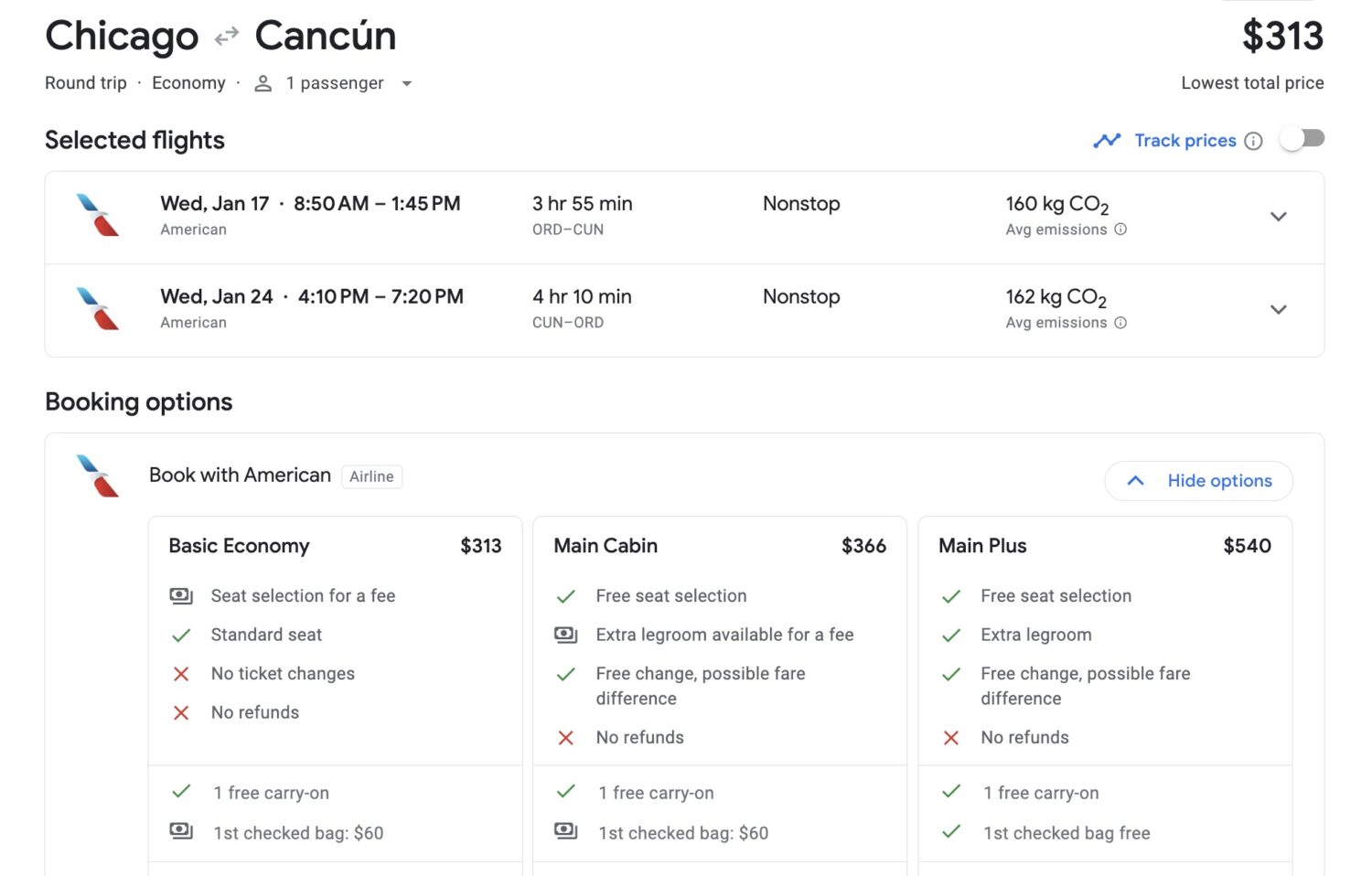
As you can see, an American Airlines main cabin fare includes free seat selection, free changes, and a free carry-on. A basic economy ticket on that same flight will get you a free carry-on bag … but otherwise doesn't include any of those things.
Every airline handles basic economy a bit different, slapping the cheapest tickets with different restrictions in hopes of convincing flyers to pay up for a pricier, more-inclusive main cabin economy fare. For example:
United basic economy and JetBlue basic economy are among the worst because they won't even let you bring a carry-on bag (unless you're flying overseas). You can bring a carry-on bag with a Delta basic economy ticket but you'll no longer earn redeemable SkyMiles or toward elite status. And starting in 2024, you can't get into Delta Sky Clubs even if you have lounge access through a credit card or membership. American Airlines basic economy hasn't gone quite that far, but you'll less than half the AAdvantage miles and credits toward elite status than you would with a standard economy fare. None of the big airlines will let basic economy travelers pick a seat for free (though there's a sneaky way to do it with Delta), so you'll need to either roll the dice on getting assigned a random seat or pay extra for seat selection.But the most important drawback of basic economy fares is universal: the lack of flexibility.
Once you purchase that lowest basic economy fare, you're pretty much stuck with it – there's no way to change your flight or cancel for a credit. Some airlines like Delta and JetBlue allow it for a hefty fee, while it's outright impossible for others. That also poses a problem if you want to rebook your flight after prices drop to pocket the savings.
But if you're certain your plans won't change, just want the cheapest fare, and aren't worried about where you sit, buying basic economy can serve you just fine. If peace of mind and some of these extra perks matter to you, paying more for a standard economy ticket can easily be worth it.
Let's be clear: Basic economy on these airlines isn't a price cut. Every time an airline has rolled out these tickets, basic economy prices have taken the place of more-inclusive main cabin economy rates, which increase. You're paying the same as you used to, and getting less.
Still, it pays to understand what you're getting no matter which ticket type you're looking at.
Read next: Everything You Need to Know About Basic Economy Fares
Cheaper Basic Economy = Cheaper Main Cabin Fares
There's a silver lining to all of this, and something that confuses many travelers who (understandably) insist they'll never book a basic economy ticket.
Basic economy and main cabin prices are tied together. When the basic economy price goes down, so does the price of a main cabin fare!
Let's say, for instance, that you wanted to book one of these sizzling roundtrip fares we sent to our Thrifty Traveler Premium subscribers flying nonstop to Europe next year.
With fares to Rome (FCO) for $437 roundtrip or flights to Barcelona (BCN) and back as low as $419, I don't blame you: Those rates are less than half the normal price. Yes, those are basic economy prices … but that price drop brought main cabin economy fares down to $617 and $599, respectively – also half the normal cost.
It's up to you to pick which you want or need: A flight in the $400 with fewer perks? Or a standard economy fare around $600 or less? Regardless, everybody wins with a cheaper-than-normal ticket.
There are some rare exceptions where this pattern doesn't play out. But as a rule of thumb, when basic economy fares go down, so do main cabin economy prices.
How Much More is Standard Economy than Basic?
It could cost you another $40 or less roundtrip to avoid basic economy … or it could cost another $200 to book a standard economy fare. It depends on where you're going.
Airlines are regularly tweaking these upgrade rates in an effort to squeeze more out of travelers. Just earlier this year, airlines raised the cost to upgrade from basic to main when flying to Europe, from $150 roundtrip to an extra $170. And in the months since, they've since raised it again.
But in the monkey-see, monkey-do airline industry, it's a pretty uniform charge no matter which airline you're flying with. The major airlines like American, Delta, United and their foreign partners generally charge the same, flat amount to bump from basic economy up to main cabin.
Here's what really matters: Where you're flying. So while you can expect an upcharge of $20 to $80 roundtrip to avoid basic economy on a simple domestic flight, that gets closer to $200 or more on long-haul international flights. For many destinations, that upgrade rate is very stable. In other places, like South America, the price differential can vary wildly from day to day, flight to flight, and destination to destination.
Here's what you can expect to pay to avoid basic economy depending on where you're heading.
Domestic Flights in the U.S.
Up to $80 for flights within the mainland, a little higher elsewhere.
To buy a main cabin economy fare for any roundtrip within the United States, you're probably going to pay at least an extra $60 beyond the basic economy price, period. That $60 (or more) upcharge has largely become an industry standard in the U.S. On most domestic U.S. flights, you're likely to pay an additional $70 or even $80, as of publication.

But if you're leaving the continental U.S., you can expect to pay even more. Many main cabin economy fares to the Hawaiian islands will cost you $100 above the basic economy price. Same goes for flights from the mainland U.S. to Alaska, though you'll occasionally see a $60 upcharge on some carriers.
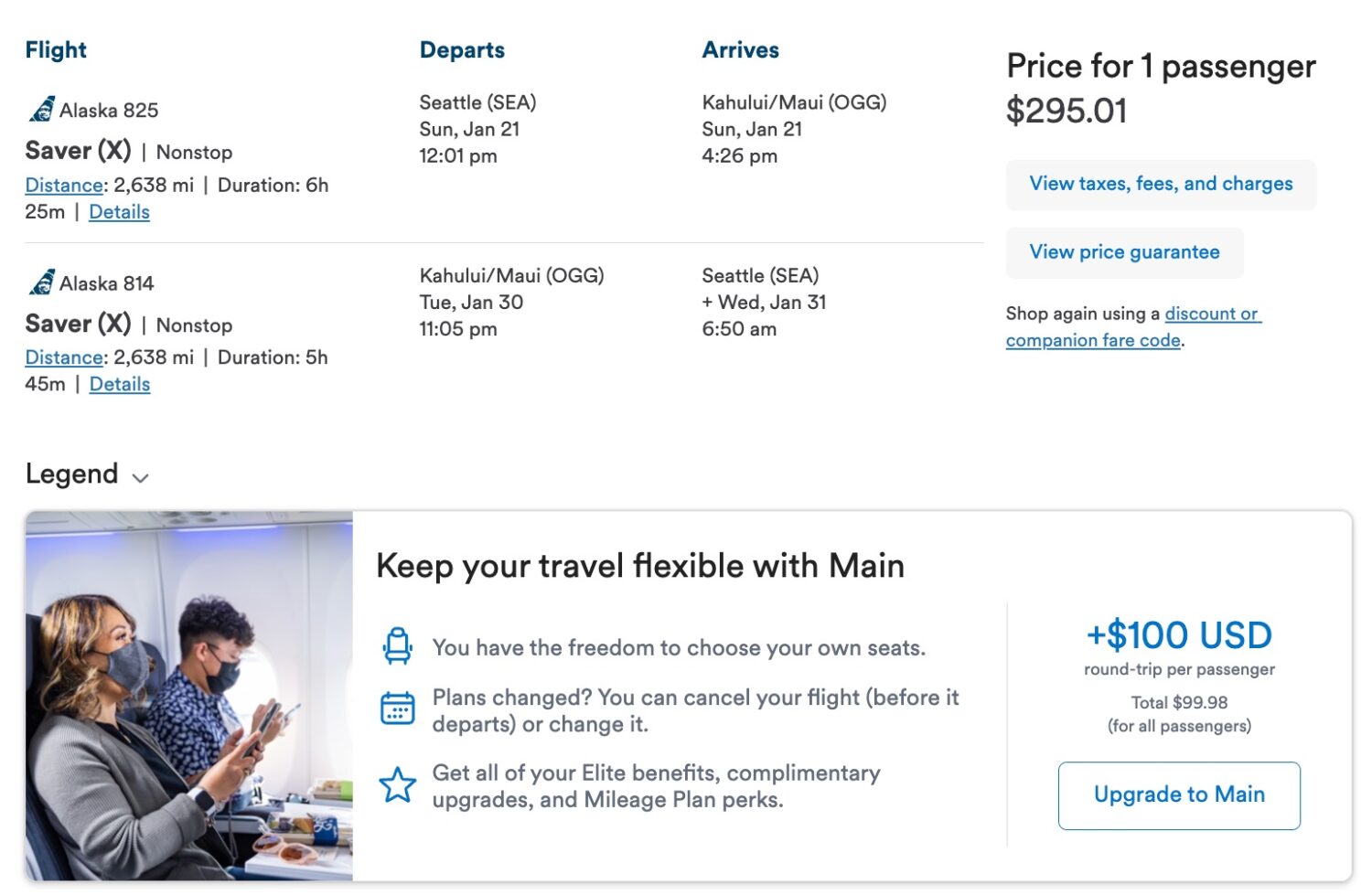
Fortunately, most main cabin fares to Puerto Rico and the U.S. Virgin Islands will cost you a flat $60 above basic economy, as of publication.
Airlines have repeatedly raised these rates over the years as a way to squeeze more revenue out of travelers. Just a few years ago, an extra $60 was the standard cost to avoid basic economy. Today, $80 has become the norm.
And as airlines make basic economy even more painful with a lack of flexibility and removing perks, we can safely expect that trend to continue.
Mexico, Canada, & the Caribbean
An extra $40 to $100 roundtrip.
If a trip down to paradise is what you seek, the main cabin economy upgrade rate can be as little as $40 more than the cheapest basic economy ticket … or as much as $100 roundtrip.
For example, this nonstop flight from Chicago-O'Hare (ORD) to Cancún (CUN) will cost you $53 more for main cabin than basic economy.

For other flights like this one to Antigua (ANU), however, the upcharge is $90.
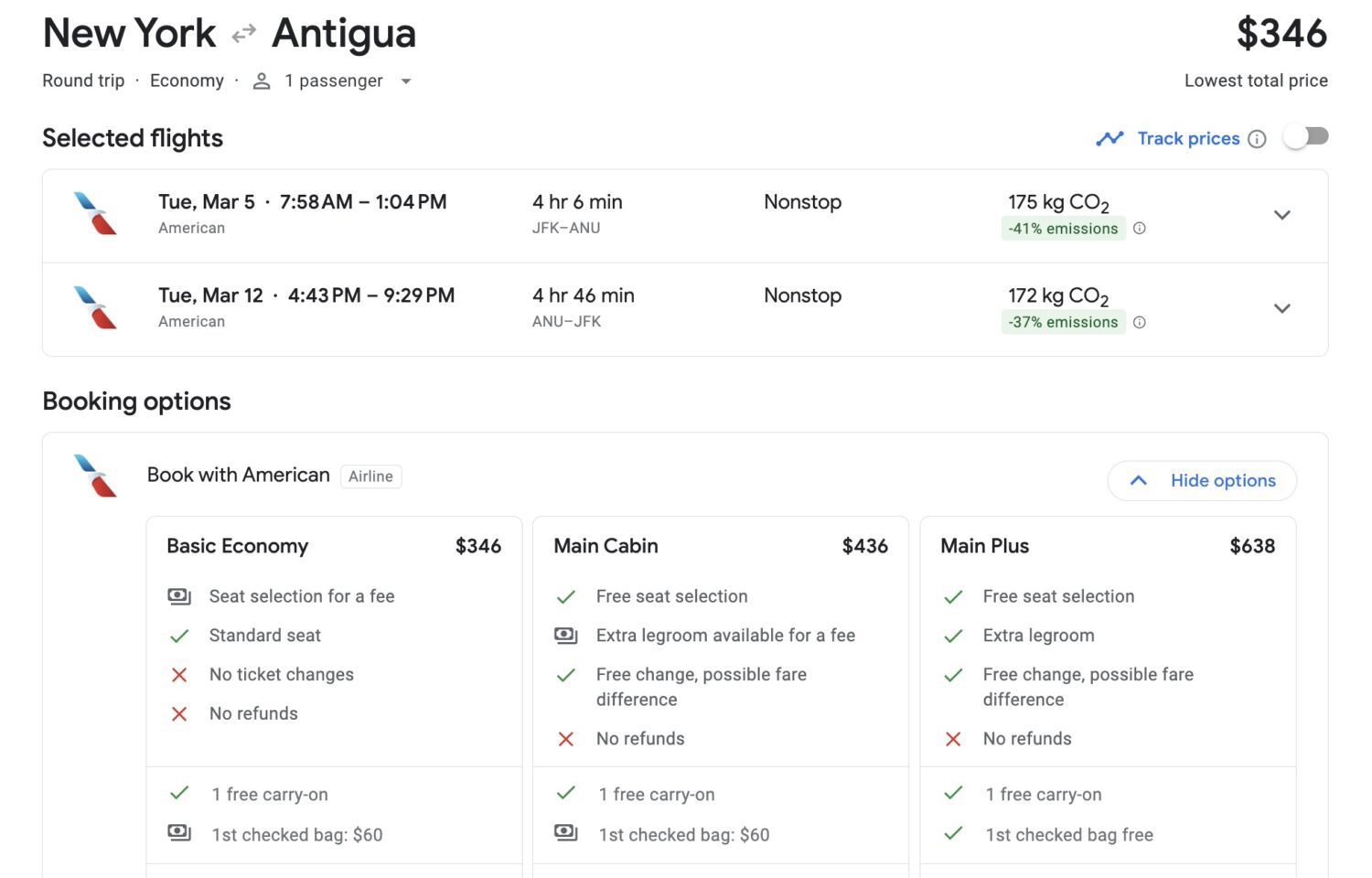
The rates vary from destination to destination and airline to airline – far moreso than what we see with domestic flights. But you'll be hard-pressed to find a standard economy fare that cost $100 more than basic economy.
Central & South America
It's a mixed bag.
When it comes to finding a normal upgrade price to avoid basic economy on flights to South America … well, there isn't one. These upgrade rates are all over the place depending on where you're flying in South America.
If you want to fly to Chile or Ecuador, we've sent fares that cost an extra $100. Same goes for Colombia. For Brazil flights, our latest searches showed $80 more Flights to Argentina were about $130 more for a better main cabin economy fare in a recent Thrifty Traveler Premium dealThe only constant is the fact that basic economy is sold on nearly every route, but the prices vary from airline to airline and from location to location.
The good news: South America is the only region of the world where unpredictability reigns. The extra cost to avoid basic economy is fairly conistent everywhere else on the planet.
Europe
An extra $180 to avoid basic economy across the Atlantic.
The cost to bump up from basic economy to a standard economy ticket between the U.S. and Europe is as standard as it gets. You can expect to see $180 upgrades on every single route operated by American, Delta, United, or one of its foreign partners.

But don't get your hopes up about missing basic economy fares altogether when crossing the pond. Today, you can safely assume that all the cheapest rates you see to Europe will be in basic economy. Other destinations may benefit from the lack of basic economy altogether, but not Europe.

If you're looking for flights to Europe using Google Flights, you'll see plenty of European airlines among the results. But thanks to their close partnerships with U.S. airlines, pricing is often identical – and that includes the cost of avoiding basic economy.
Africa
An extra $180 to avoid basic economy.
Much like Europe, the same exact fare structure works for flights to Africa on the big three carriers and their partners, too.

But unlike Europe, you'll occasionally luck out and find flights to Africa booking into main cabin fares at the lowest rate. This Thrifty Traveler Premium alert for fares to Nairobi (NBO) featured only main cabin fares, for instance.

Asia & Oceania
Pay an extra $200 to book a main cabin fare.
The ultra-long flights to Asia and Oceania were among the last to get hit with the rollout of basic economy fares. And the difference is higher, too: You can typically expect to pay an extra $200 to avoid basic economy when crossing the Pacific Ocean, with a few, slightly lower exceptions.

Whether you're flying American, Delta, United or their partners, that $200 is standard for flights to Sydney (SYD) or Tokyo.

In some cases – and seemingly at random – you could get lucky and stumble onto flights that don't have basic economy fares available, period. Those fares could simply be sold out, or the airline might have simply decided not to sell them.

In some rare instances, that upgrade rate could be slightly lower, like this $160 upcharge from a recent Thrifty Traveler Premium deal to Singapore (SIN).

Tips & Tricks to Beat Basic Economy
Much as we love Google Flights, the site doesn't allow you to filter out basic economy results. Add it to our 2024 wishlist, would you, Google?
But remember: A cheaper basic economy flight almost always means you can book a cheaper main cabin fare, because those prices are tied together.
If you're still set on avoiding basic economy altogether, there are a few easy ways to do so.
Fly Southwest
There's one U.S. airline that doesn't do basic economy, and that's Southwest. And the company has vowed they never will.
The budget-friendly carrier offers four different fare classes onboard its economy-only Boeing 737s, but none of them come with the restrictions of basic economy. Even Southwest's cheapest “Wanna Get Away” tickets come with free changes and cancelation for a voucher. Southwest has open seating, so there's no seat selection to worry about – just a boarding order. You still get two free checked bags with every ticket, too.
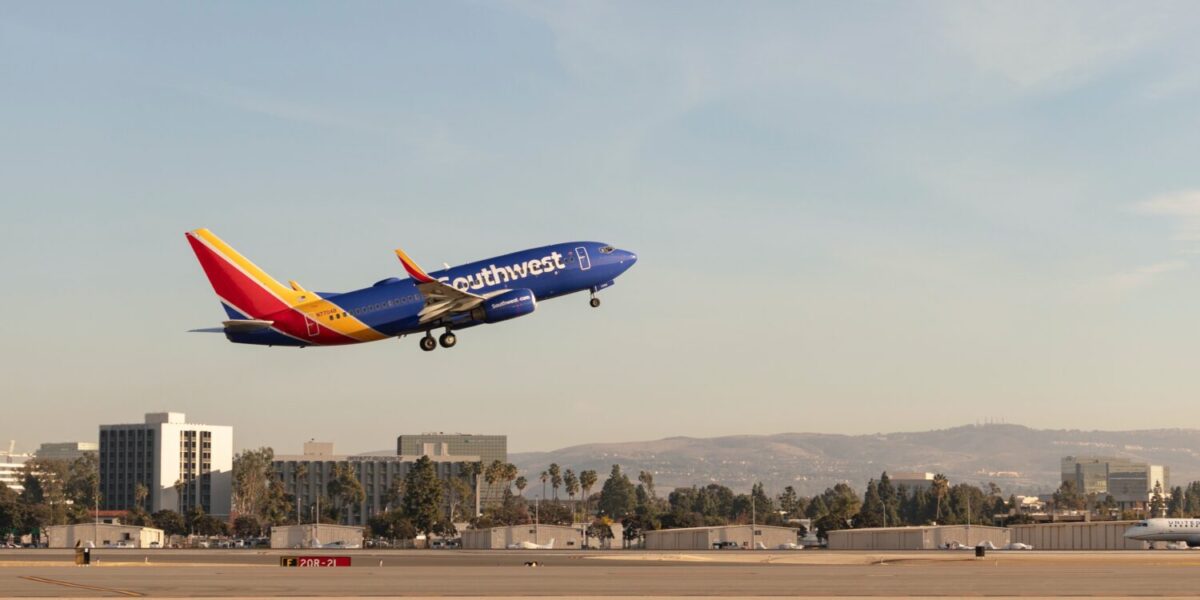
Southwest is a different animal than the other major U.S. airlines, so this isn't exactly an apples-to-apples comparison. But if avoiding basic economy is at the top of your list, Southwest should be, too.
JetBlue & United Domestic Flights (With a Carry-On Bag)
While Google Flights won't let you exclude basic economy altogether, there's a crafty workaround to avoid the worst of the worst of these pesky fares: Filter for tickets that include a carry-on bag.
With that simple addition, you can zero out results that include JetBlue and United basic economy – neither of which include a free carry-on bag when flying domestically. It'll also exclude the ultra-low-cost carriers like Spirit, Frontier, Allegiant, and Sun Country.

Get Your Airline's Co-Branded Credit Card
From the *delta skymiles gold card* to the *united explorer*, having an airline's co-branded credit card in your wallet can take some of the sting out of basic economy.
These cards won't get you a free seat assignment or ticket flexibility, but most of them come with nearly identical perks, including:
Priority boarding, so you won't need to pray there's still overhead bin space for your carry-on bag A free checked bag for you and two (or as many as eight) additional passengers on your reservation United's credit cards will even let you bring a carry-on bag onboard, though it's one of the few airline credit cards that require you to pay with the card in order to get that perk.
Routes Spared from Basic Economy
Officially, basic economy have spread worldwide.
Unofficially, though, there are still a handful of destinations where you're far more likely (if not absolutely certain) to avoid the pain of basic economy altogether.
Dubai & India
Two places far, far away where you can almost always exclusively find main cabin fares are Dubai and India.
We sent this flight deal to our Thrifty Traveler Premium members just a few days ago, and it included more than two dozen U.S. and Canadian airports with sub-$800 roundtrip fares to Dubai. Even with a $180 or more upgrade to main cabin, this would have been a great deal … but like all the cheap flights to Dubai (DXB), we found that these fares were main cabin!
The same goes for flights to India, like this New Delhi (DEL) deal we sent a few weeks ago.
Cuba
When flying to Havana (HAV), Varadero (VRA) or any of Cuba's other airports, your fare is always main cabin no matter what – basic economy doesn't exist.
Why? Because every fare you purchase flying to Cuba includes health insurance as required by the Cuban government. It's just another reason why you should visit this beautiful island, along with the low, low prices.
The U.S. and Cuba have had a long, fraught relationship, so a little extra ticket flexibility isn't the worst idea in the world. Considering you have to purchase a visa, too, it helps to have that additional peace of mind when making the short hop down to Havana.
Hawaiian Airlines (To the South Pacific & Beyond)
Hawaiian Airlines is a gem of the travel world, and we know Alaska Airlines agrees! Not only does Hawaiian's network connect U.S. travelers to Hawaii for some awesomely low prices from time to time, it also connects Honolulu (HNL) to islands all over the Pacific and across Asia, too.
There's perhaps no cooler route on Hawaiian than the Cook Islands, and wouldn't you know it, the new route went on sale last week. And in this case – as is always the case – the lowest price was still a main cabin fare.
Airports like Los Angeles (LAX), Oakland (OAK), Portland (PDX), Sacramento (SMF), San Diego (SAN), and Seattle (SEA) all benefitted from $894 roundtrip fares to the Cook Islands with one quick stop in Honolulu (HNL). Plus, those fares were eligible for a stopover in Hawaii for just a few dollars more!
Sadly, Hawaiian's fares flying from the U.S. to Hawaii itself still have confusingly named “Main Cabin Basic” fares on them, which are just basic economy in disguise. But the rest of Hawaiian's network west of the islands is main cabin all the way!
Use Your Airline Miles
One of the best ways to circumvent basic economy is simple: Just use your airline miles instead.
In 999 cases out of 1,000, any time you're redeeming airline miles means you're getting a standard economy ticket with free seat selection and free cancellation, leaving the painful restrictions of basic economy behind. So if you're weighing using miles versus paying cash, this could swing you toward using your miles instead.
Sadly for loyal Delta flyers, SkyMiles are the exception to this rule. Delta was the first airline to roll out basic economy awards when using miles – and as of publication, they're still the only airline to do it. Worse yet, these pesky basic economy award tickets have now spread worldwide.

Keep reading for a workaround to see how you can book Delta flights with miles and avoid basic economy!
But whether you're redeeming American AAdvantage miles to fly to Miami (MIA) or Madrid (MAD), booking with your United MileagePlus miles, booking a United flight to Hawaii and back for just 15,000 miles roundtrip using Turkish miles, or using any one of the countless workarounds to book flights using a partner airline's mileage program, you'll be spared from basic economy.
While neither American Airlines nor United have matched Delta's frequent SkyMiles flash sales, they occasionally sell award flights at a steep discount. And when they do, those still book into a main cabin fare, like this recent flash sale to Sydney (SYD) from just 56,000 miles.
Book Your Delta Flights Using a Workaround!
Want to save points and avoid basic economy with Delta? We got you.
You can book Delta economy flights using miles from partner airlines like Air France/KLM and Virgin Atlantic, regularly at far cheaper rates than what Delta itself is charging. And while you'll regularly get a basic economy fare when redeeming SkyMiles, these partner award tickets always get you into main cabin on your Delta flight!
Here's a quick example with flights from Minneapolis-St. Paul (MSP) to Honolulu (HNL). Using SkyMiles, Delta would charge you a whopping 134,000 SkyMiles for a basic economy fare – and 150,000 SkyMiles for main cabin. Ouch.

But booking Delta flights through Virgin Atlantic Flying Club is one of our favorite workarounds to save SkyMiles – and you get a main cabin fare with free seat selection, to boot! Even after a recent hike, you can book these exact same flights to Honolulu for 70,000 points. That's right: Half of what Delta wants!

Turning to Air France/KLM Flying Blue miles, it's even better: Just 54,000 miles roundtrip. And just like Virgin Atlantic, you're getting a Delta main cabin economy ticket for that price – in this case, for nearly a third of the SkyMiles Delta is charging for a basic ticket.

It works all across Delta's network, from the shortest regional hops to the longest of ultra-long flights. You're going to want to pick your own seat so you don't get stuck between two strangers on the 16-hour flights to and from Cape Town (CPT) in South Africa!

Bottom Line
You can't tell the difference between basic economy and standard main cabin once you're on the plane. But from check out until the time you board or need to cancel, there are critical differences in how much these fares cost, where you'll sit, what kind of miles or status you can earn, and flexibility, too.
Understanding these differences is key. But it's even more important to understand that whether you're fine booking the cheapest basic ticket or swear you never will, you can use that knowledge to get ahead.




